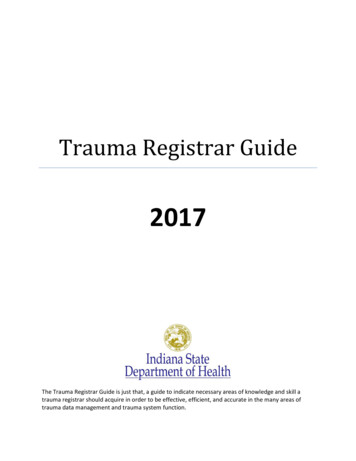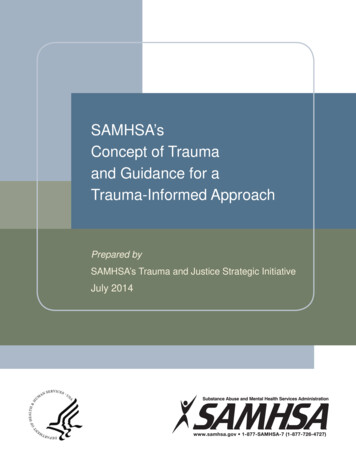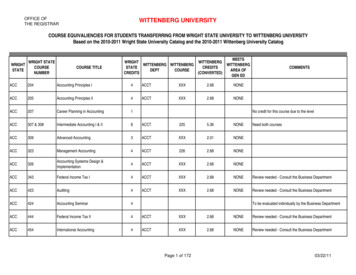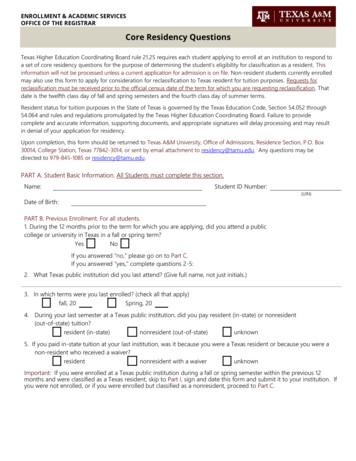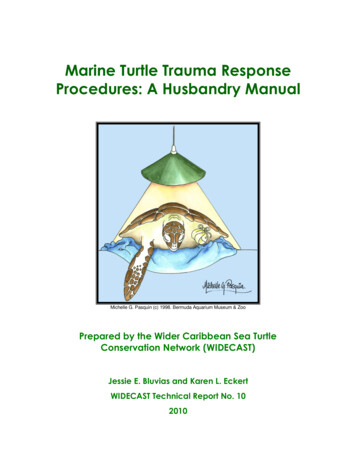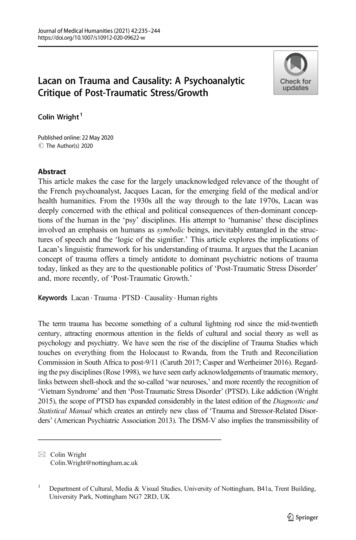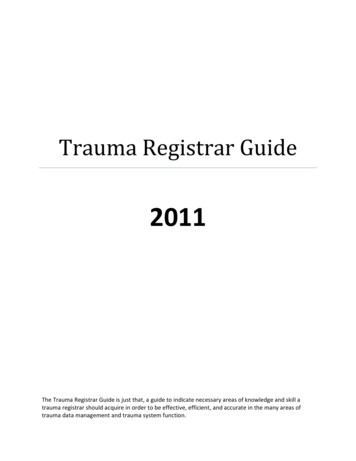
Transcription
Trauma Registrar Guide2011The Trauma Registrar Guide is just that, a guide to indicate necessary areas of knowledge and skill atrauma registrar should acquire in order to be effective, efficient, and accurate in the many areas oftrauma data management and trauma system function.
Trauma Registrar Guide-2011A primary purpose of aggregating trauma related data across the nationand within a state is to provide data for research purposes and to have evidenceto direct and improve treatment which can maximize positive outcome for thetrauma population. Good data provides evidence for benchmarking and processimprovement activities as well as a base from which to develop standards ofcare. In order to preserve data integrity, each data element must be collected, asclosely as possible, by the same definition and according to the same guidelinesby each facility that contributes to a state or national database.The integrity and value of data entered into a trauma registry database willbe directly affected by the training and expertise of the Trauma Registrar whoabstracts, enters, and manages the data. The American Trauma Societyprovides a combined Basic and Advanced Course that should be considered theminimum necessary trauma registry training. Knowledge of medical terminologyand human anatomy are also important especially in light of the scheduledimplementation of ICD-10-CM in 2013. The focus of this manual is to provideclarity of definition and process guidance as the NTDB , National TraumaDatabank, national elements are entered into facility trauma registries foruploading into the state and national databases. Once the data has beenentered in a facility trauma registry, the data will then be uploaded directly or bemapped to the corresponding fields at the state and national level; therefore,monitoring data mapping and understanding software functionality will be anecessary task for the trauma registrar in every trauma department.The Trauma RegistrarThe Trauma Registrar position requires a knowledge base in many areas such asmedical terminology, coding, pathophysiology, data management and presentation,software functionality, statistics, anatomy, and an understanding of the trauma patientcare processes. To remain current the trauma registrar must take responsibility forcontinuing self education.Experience in the medical field, whether in a physician’s office, in a hospital, or inemergency medicine, is of great benefit to the entry level trauma registrar. Additionally,coursework in coding (ICD-9-CM and ICD-10-CM), data management, statistics, theanatomy of injury, registry software functionality, and trauma related continuingeducation courses will add to the skill set and understanding of the trauma registrar.Several organizations offer learning opportunities to assist trauma registrars indeveloping their knowledge base and skill sets.2
1. The American Trauma Society offers the combined Basic and Advanced TraumaRegistry course. (CSTR--Certified Specialist in Trauma Registry credential byexamination)2. AAAM offers the AIS, Abbreviated Injury Scaling, course which teaches thecoding of traumatic injury.(CAISS--Certified Abbreviated Injury Scale Specialistcredential on examination)3. State registry organizations often offer educational opportunities.The CSTR, Certified Specialist in Trauma Registry, credential as well as the CAISS,Certified Abbreviated Injury Scale Specialist, credential are evidence of mastery of thecore trauma related data and critical care processes which are common to every traumadepartment and system.In order to take the CSTR exam one must meet the following requirements:1. A minimum of a high school diploma or equivalent2. At least 2 years of full – time or the equivalent (4,000 hours) experience intrauma registry practice.3. Completion and filing of an Application for the Certification Examination forTrauma Registrars.4. For more information contact http://www.amtrauma.org/courses/exam cert.html.In order to take the CAISS exam with success, it is highly recommended that theAbbreviated Injury Scaling course be completed. It is also recommended that at leastone year of coding experience be accumulated in order to understand coding thoughtprocesses and be able to accurately code injuries in all 6 body regions.Trauma Registry SkillsIn general there are four basic skill sets that the Registrar will need to master.1.2.3.4.Data Management – data integrity, reports and data presentationAnatomy and Conditions of InjuryCoding and Scoring ConceptsRegistry Issues – NTDB , state, and facilityIt is necessary to know how to manage data analysis, know anatomy, understandanatomical injury, be able to apply the coding rules and guidelines as provided in theAIS dictionary, and know how the registry software works. Even when the registrysoftware allows text entry and maps to ICD-9 and AIS codes, it is important to know ifthe mapping is correct and the resulting codes accurately reflect the injury. The ICD-10coding process, already in use internationally, is scheduled to be implemented in theUnited States beginning October 1, 2013. Thus, it will be important to understand howto code injuries using both coding systems. For instance, the Injury Severity Scores3
(ISS) are dependent on the correct AIS codes which generate the severity digit as thepost dot value.The following discussion will take each of these key registrar skill sets and describemany of the issues that are important for the trauma registrar to know within each of therelated topics.I. Data ManagementA. Inclusion Criteria1. American Collegeof SurgeonsGuidelinesThe definition of a “Trauma Patient” can be found in theAmerican College of Surgeons: “Resources for OptimalCare of the Injured Patient”, often referred to as the“Bluebook or Greenbook” depending upon the year ofpublication. Any patient that meets this definition shouldbe entered into the Trauma Registry.2. Diagnosis Codes800 – 959.9The ACS inclusion criteria begins with any patient thathas an injury in the code range between 800 and 959.9,but not one of the exclusion codes and meets one of thethree event criteria below.1Patients are to be excluded if they are coded using ICD9-CM exclusion codes for late effects of injury (905909.9), superficial injuries, including blisters, contusions,abrasions, insect bites (910-924.9), and foreign bodies(930-939.9).The event must also include one of the following:1. Hospital admission;2. Patient transfer via emergency medicalservices transport from one hospital toanother hospital; or,3. Death resulting from the traumatic injury. 13. Local / StateRequirementsLocal and State organizations may add additionalcriteria as desired, for example, Missouri regulationsfollow NTDB guidelines and include traumatic hipfractures, and single level fall injuries, regardless of age.4. DepartmentChange LogRegistry Change Logs – Each Trauma Departmentshould maintain a Registry Log. The Registry Logcontains a listing of each change, or update to theRegistry software. It is to include the specific changes,4
software upgrades, and any changes that are made tothe user defined fields, additions and deletions, alongwith the date of each event. The log should be reviewedat least annually.Note: NTDB has an annual change log that isincluded with the Dictionary updates.B. Data Abstraction1. Identification ofRequired DataElements PointsData Abstraction - “no data is better than bad data,” ifan element is unknown, don’t guess, enter unknown oras appropriate. Follow NTDB and state guidelines.Concurrent abstraction - daily abstraction while thepatient is in house.Retrospective abstraction - abstraction after patientdischarge.Hybrid - data entry is begun during the patientencounter but the record is closed after patientdischarge.2. Data Entry andVerificationThe American College of Surgeons registry staffingrecommendation for manual data entry is 1full-timeequivalent employee dedicated to the registry toprocess the data for approximately 750 to 1,000patients annually (ACS). This may vary depending onthe amount of data collected and the proportion that canbe imported from the hospital information system intothe trauma registry.1As registries begin to use data imported from thehospital EHR, the registrar responsibilities may expandfrom mainly data entry to include data validation of theinformation imported from the various hospital systemsas well as from the electronic medical record.1C. Reports1. BasicsIn order to run data for reporting the registrar needs toknow several basic details: what information is neededto identify the correct data fields, the time frame that isof interest, any related filters, and what format fordisplay grouping, such as year, month, ISS range, agerange, etc.5
2. Presentation Conceptsa. FormatThe way that the viewer wishes to view the result of thedata compiled. The format identifies how the data is tobe displayed such as paper, website, dashboard,PowerPoint presentation, etc.b. TablesShow the actual data elements arranged in rows andcolumns.c. GraphicsA picture showing the result of data calculations.Graphic displays of information generally work betterthan tables for faster interpretation of changes, trends,and outliers.1. Bar GraphsHorizontal or vertical bars proportional to the values ofthe data. These are used for quick comparison ofinformation.122. Pie ChartsShow proportions of a whole or percentage of a whole.123. Line GraphsLine connecting data points in a sequential order to showa trend over time.6
124. OthersControl Charts – used to observe performance bystudying variation over time and monitors if a process iswithin control or out of control limits using upper andlower control lines calculated using standard deviation orsigma values with the center line representing the overallaverage.12Dashboard - a compact visual presentation of criticaldata, usually at a higher level, to be easily understood ata glance.Spreadsheet - a collection of data in columns and rowsthat hold the data detail -- usually produced in an “Excel”type of document.12PatientsHospLOSAve 238.912.356.411.042.712.435.912.043.812.415Scatter grams - displays values for two variables showingthe distribution of the values. 127
Pareto chart – typically a chart showing data from mostto least frequently occurring information from left to right.These are used to clearly identify higher valued items(e.g., The highest frequency or priority for resolution).12RadarChart - (same as spider gram) shows the relationshipbetween multiple variables with one or more axis.12Tree Chart (Fishbone diagram) – used to identify all ofthe various issues/tasks that go into development of asingle outcome.8
3. Interpretationa. VolumeData Totals, such as total patients. These can be easilyvisualized by a bar chart (similar to a histogram) showingdifferent heights depicting variance from comparativeitems or periods of time.b. TrendsA trend is a series of consecutive information/data that isall moving upward or downward as time progresses. Atrend line can be overlaid onto the chart information/ datafor the reader to more easily visualize if there is a trendover time.D. Performance ImprovementPIPS Process Improvement Patient Safety – Uses the continuous process ofrecognition, assessment, and correction. This includes processes such as datacollection, collation, analysis, modification, and instruction.1. Standardsa. American Collegeof SurgeonsThe American College of Surgeons is aneducational association of surgeons created in 1913 toimprove the quality of care for the surgical patient bysetting high standards for surgical education andpractice.1The American College of Surgeons originated theNational Trauma Data Bank. It is a voluntary nationaldata repository of information related to traumapatients. In order to provide standardization of data,the National Trauma Data Bank has published adefinition of the “trauma patient”. This definition shouldbe used to guide the trauma registrar in determiningwhich patients are to be included in this database.(Inclusion criteria page 4.)Additional information can be found regarding therecommendations for PIPS processes through thefollowing ACS formanceimprovement and patient safety reference manualb. Joint Commissionof Accreditation ofHealthcareOrganizationsThe Joint Commission of Accreditation of HealthcareOrganizations (http://www.jointcommission.org) wascreated by merging the Hospital StandardizationProgram with similar programs run by the American9
College of Physicians, the American HospitalAssociation, the American Medical Association, andthe Canadian Medical Association. It is a nationalorganization that provides standards so that hospitalsmay obtain accreditation for licensure and gain theright to receive payment from Medicaid andMedicare.32. BenchmarkingA benchmark is a standard by which something can bemeasured or judged, comparing like data over timewith different organizations, providers, or with arecommended or desired outcome/standard.Filters: Filters are tools that can be used to gatherdata into specifically defined groups, or a single item.Filters are used to easily define, view, or calculatesubgroups within a larger population such as, allburns, all deaths, age groups, ISS Ranges, etc.ICU Day a count of any day, or partial day, that thepatient was in an ICU. For example: if the patient wasadmitted at 11pm on one day, and discharged at 10am the next day, this will equal 2 (two) ICU days, sincethe stay included 2 (two) 24 hour days.5For more information, see the NTDB Data Dictionarywhich can be found etDictionary.htmlIf a calculation is required, it will be necessary tounderstand how to correctly define the field and/or howto calculate the item in order to compare theinformation. For example:Average ICU Days the number of total ICU Days forthe period divided by the total number of patients thathad an ICU stay.Average Ventilator Days the total number of daysthat the patients were on a ventilator, divided by thetotal number of patients that had been on a ventilator.Mortality Rate the total number of deaths for theperiod, divided by the total patient population for thatperiod.10
3. PI and Loop Closurea. Identification ofIssuesIssues can be identified through many differentavenues such as, communication from staff, patientsatisfaction, risk management, chart review processes,trauma meetings/rounds, and direct patient interaction.b. Review of IssuesPI review process whereby the issue is brought to theTrauma Medical Director for evaluation, determinationof issue and if there is a need for corrective action.c. Corrective ActionWhen a consistent problem or inappropriate variationis identified, corrective actions must be taken anddocumented. Examples of corrective actions are: newguidelines, protocol change , or pathway developmentand review, targeted education, enhancedresources/facilities, or communication, processimprovement team implementation, counseling, peerreview presentation, change in provider privileges orcredentials, or external review.1d. Result EvaluationDemonstration that a corrective action has the desiredeffect determined by on-going or repeat evaluation. 1E. Statistics1. PopulationDemographicsThe demographics of a population involves analysis ofdiffering grouping of items such as the population age,gender, residence, nationality, etc.2. SamplingThe process of taking a small portion of a larger set ofdata to study in order to obtain a picture of the probablelarger total population. This can save time and money.3. Calculationsa. FrequenciesFrequency is the number of occurrences of a repeatingsimilar event that is identified within a defined set ofreference.b. AveragesAverage or mean is the sum of the value of all integers11
divided by the total number of integers.The average or mean is the total all of the values,divided by the count of numbers in the listing of values,e.g., 9 8 7 6 5 5 5 3 2 50/ 9 4.5.c. PercentagesParts of an identified measured whole, typicallyobtained by taking the total of one group and dividing itby the total of the entire group. For example: The totalnumber of pediatric patients in a group is 20. The totalnumber of patients including pediatrics is 200. To findthe percent of pediatric patients: 20/200 10% of allpatients are pediatric patients.d. RangesThe difference between the largest and the smallestnumber in a series.e. RatiosOne value as compared to another, i.e., frequency ofoccurrence as in one in 240, e.g., 1:240.f. OthersMean The same as average.The median is the integer holding the middle position ina sequential listing of numbers.The median when arranged :987655532Mode the integer that occurs most often (i.e., 5 7 5 9 35 2 6 8) in this cluster is 5. Therefore, the mode wouldbe 5.Standard Deviation: a measure to quantify thedifference between the values in the data set.g. Report RequestsReport requests should be approved by the TraumaDirector or IRB (Institutional Review Board) ifappropriate. A cover letter with requester identification,the date of request, identification of data requested andpurpose, time frame for the data search, and theidentification of trauma registrar providing data, as wellas contact information should be included with the data.Report requests are usually for aggregate de-identifieddata.In all cases HIPAA guidelines should be followed.12
II. ANATOMY AND CONDITIONS OF INJURY - Anatomy is VERY important.To accurately code an injury one must know much more than whichbone or organ was injured. Understanding the various descriptors usedin documentation and in the detailed anatomy of each particular bone ororgan will be necessary to accurately apply codes.An understanding of the mechanisms and types of Injury will benecessary as well for optimum accuracy in applying ICD 9 and AIScodes.A. Basic Anatomy1. Head / NeckSee the reference list and/or search the internet toassist with the identification and location of eachbone/organ.Head: Ethmoid bone, frontal bone, occipital bone,parietal bones x 2, sphenoid bone, temporal bone x 2.Brain: Adult average brain weighs approximately 3pounds with 500 milliliters of cerebral spinal fluid(CSF).Neck: Cervical vertebrae x 7, trachea, esophagus,larynx, pharynx, hyoid bone.2. FaceFacial bones: 14 stationary bones and a lower jawbone. Inferior nasal conchae x 2, lacrimal bones x 2,mandible, maxilla x 2, nasal bones and septum, palatinebones x 2, vomer, zygomatic bones x 2, eye, ear.3. ChestChest: Thoracic spine, ribs 1-12, sternum, heart,bronchi and lungs, thoracic aorta, diaphragm, thoracicesophagus.4. AbdomenAbdomen: Liver, spleen, colon, rectum, small bowel,pancreas, kidneys, pelvis, uterus, bladder, stomach,gallbladder, retroperitoneum, abdominal aorta and othervessels.5. SpineSpinal Column: Cervical--7, thoracic--12, lumbar--5,sacrum—5 (fused), coccyx (tailbone)—2, 3, or 4.Note: C1 Atlas, C2 Axis and has a “dens” (spikelike projection) that projects upward on which the atlas13
rotates.Vertebrae parts: Vertebral body, spinous process,transverse process, pedicle, foramen, lamina, superiorand inferior articular processes.Note: The 5 separate bones of the sacrum begin tofuse during the late teen years and are usuallycompletely fused by 25 or 26 years of age. Coccygealvertebrae are also fused.6. ExtremitiesUpper Extremities:Shoulder girdle with scapula and clavicle.Humerus: Median and lateral epicondyle (end ofhumerus), capitulum, trochlea, coronoid fossa, deltoidtuberosity, greater & lesser tubercle, head & neck. 10Ulna: Olecranon process (elbow), coronoid process,ulnar tuberosity, styloid process (projection at the distalend of the ulna).Radius: also has a styloid process at the distal end.Hand: Carpal bones x 8 (scaphoid, locate, triquetrum,pisiform, trapezium, trapezoi
Registry course. (CSTR--Certified Specialist in Trauma Registry credential by examination) 2. AAAM offers the AIS, Abbreviated Injury Scaling, course which teaches the coding of traumatic injury.(CAISS--Certified Abbreviated Injury Scale Specialist credential on examination) 3. State registry organizations often offer educational opportunities.
